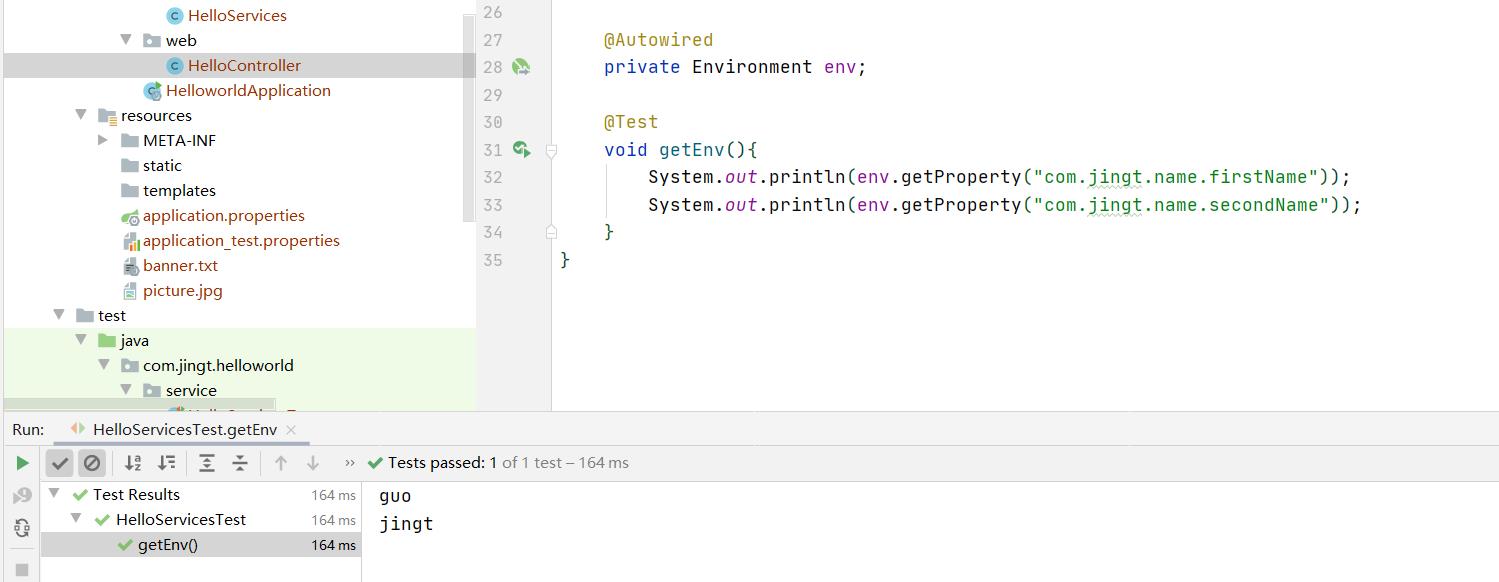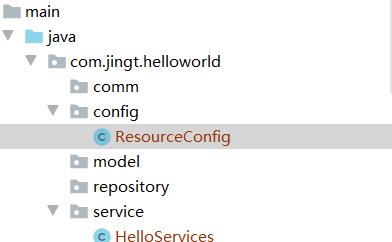Spring Bootspringboot中自定义配置项
Posted 是馄饨呀
tags:
篇首语:本文由小常识网(cha138.com)小编为大家整理,主要介绍了Spring Bootspringboot中自定义配置项相关的知识,希望对你有一定的参考价值。
文章目录
2. 自定义配置项
在项目开发的过程中,经常需要自定义系统业务方面的配置文件及配置项,Spring Boot提供了@value注解、@ConfigurationProperties注解和Environment接口等3种方式自定义配置项。
@value
在实际项目中,经常需要在配置文件中定义一些简单的配置项,Spring Boot提供@Value注解来设置简单的配置项,默认读取application.properties文件中的配置属性。
我们在application.properties配置文件下自定义配置属性。

然后在使用的位置调用@Value注解来获取配置项的值,如下所示:
@Value("$com.jingt.name.firstName")
private String firstName;
@Value("$com.jingt.name.secondName")
private String secondName;
public String testValue()
return firstName + "|" + secondName;
@Autowired
private HelloServices helloServices;
@Test
void testValue()
System.out.println(helloServices.testValue());

注意:
-
使用@Value注解时,所在类必须被Spring容器管理,也就是使用
@Component、@Controller、@Service等注解定义的类。 -
@Value需要传入完整的配置项的Key值。 -
@Value注解默认读取application配置文件,如果需要使用其他的配置文件,可以通过@PropertySource注解指定对应的配置文件。在启动类上加注解@PropertySource
@SpringBootApplication
@PropertySource(value = "classpath:application_test.properties")
public class HelloworldApplication
public static void main(String[] args)
SpringApplication.run(HelloworldApplication.class, args);
在application_test.properties 配置文件中加入
com.jingt.name.firstName=guo1
com.jingt.name.thirdName=jingt1
@Value("$com.jingt.name.firstName")
private String firstName;
@Value("$com.jingt.name.thirdName")
private String secondName;
public String testValue()
return firstName + "|" + secondName;
把secondName改为thirdName,firstName从guo改为guo1

会发现thirdName也已经获取到了,firstName还是为guo,这是因为application.properties配置文件加载的优先级的原因,application.properties会覆盖application_test.properties对应文件中的值。
Environment接口
Environment是Spring为运行环境提供的高度抽象的接口,它会自动获取系统加载的全部配置项,包括命令行参数,系统属性,系统环境,随机数,配置文件等。使用时无须其他的额外配置,只要在使用的类中注入Environment即可。
在application.properties文件中增加自定义配置项
com.jingt.name.firstName=guo
com.jingt.name.secondName=jingt
Environment读取的是系统中所有的配置。我们既可以在application.properties中设置自定义的配置项,又可以在自定义配置文件中添加配置项。
将Environment对象注入,获取系统配置
@Autowired
private Environment env;
@Test
void getEnv()
System.out.println(env.getProperty("com.jingt.name.firstName"));
System.out.println(env.getProperty("com.jingt.name.secondName"));
引入的是import org.springframework.core.env.Environment;,不要引入错了。

使用Environment时还需要注意以下两点:
- 使用Environment无须指定配置文件,其获取的是系统加载的全部配置文件中的配置项。
- 需要注意配置文件的编码格式,默认为ISO8859-1。
@ConfigurationProperties
在实际项目开发中,需要注入的配置项非常多时,@value和Environment两种方法就会比较烦琐。这时可以使用注解@ConfigurationProperties将配置项和实体Bean关联起来,实现配置项和实体类字段的关联,读取配置文件数据。
在resources下创建自定义的website.properties配置文件,增加配置属性。
com.jingt.resource.name=jingt
com.jingt.resource.website=com.jingt.com
com.jingt.resource.language=java
创建一个配置类

@Configuration
@ConfigurationProperties(prefix = "com.jingt.resource")
@PropertySource(value = "classpath:website.properties")
public class ResourceConfig
private String name;
private String website;
private String language;
public String getName()
return name;
public void setName(String name)
this.name = name;
public String getWebsite()
return website;
public void setWebsite(String website)
this.website = website;
public String getLanguage()
return language;
public void setLanguage(String language)
this.language = language;
我们使用了@Configuration注解、@ConfigurationProperties和@PropertySource三个注解来定义WebSiteProperties实体类:
- @Configuration定义此类为配置类,用于构建bean定义并初始化到Spring容器。
- @ConfigurationProperties(prefix = “com.weiz.resource”)绑定配置项,其中prefix表示所绑定的配置项名的前缀。
- @PropertySource(value = “classpath:website.properties”)指定读取的配置文件及其路径。@PropertySource不支持引入YML文件。
通过上面的WebSiteProperties类即可读取全部对应的配置项。
在单元测试中,我们测试是否可以通过
@Autowired
private ResourceConfig config;
@Test
void getResourceConfig()
System.out.println(config.getName());
System.out.println(config.getWebsite());
System.out.println(config.getLanguage());

使用配置文件注意事项
- 使用YML文件时注意空格和格式缩进。
- Properties文件默认使用的是ISO8859-1编码格式,容易出现乱码问题。如果含有中文,加入spring.http.encoding.charset=UTF-8配置即可。
- Properties配置的优先级高于YML文件。因为YML文件的加载顺序先于Properties文件,如果两个文件存在相同的配置,后面加载的Properties中的配置会覆盖前面YML中的配置。
- @PropertySource注解默认只会加载Properties文件,YML文件不能使用此注解。
- 简单值推荐使用@Value,复杂对象推荐使用@ConfigurationProperties。
- 只有Spring容器中的组件才能使用容器提供的各类方法,所以,配置读取类需要增加@Component注解才能加入Spring容器中。
以上是关于Spring Bootspringboot中自定义配置项的主要内容,如果未能解决你的问题,请参考以下文章